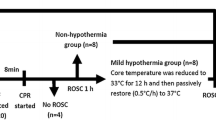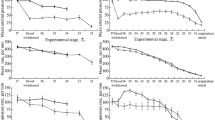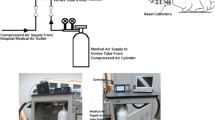Abstract
We investigated the optimal brain temperature during the period of retrograde cerebral perfusion (RCP). Eighteen mongrel dogs were divided into three groups according to brain temperatures during the period of RCP: L (15°C), M (20°C), and H (25°C). Following hypothermia using cardiopulmonary bypass (CPB), RCP was performed for 60 minutes via the bilateral internal maxillary veins with a perfusion pressure of 25 mmHg. The animals were then rewarmed for 60 minutes. Cerebral blood flow (CBF) was measured by laser Doppler flowmetry. The cerebral metabolic rate for oxygen (CMRO2) and glucose (CMRGlu), excretion of carbon dioxide (ExCO2), and lactate/pyruvate (L/P) ratio were calculated. During the period of RCP, brain temperature significantly (p<0.05) increased in Group L. CBF, CMRO2, ExCO2, and CMRGlu significantly (p<0.05) decreased to less than 20% of the baseline levels during the period of RCP in all groups. After RCP, CBF recovered noticeably beyond the baseline levels in Group M (130%). CMRO2 and ExCO2 levels in Groups M and H tended to be higher than those in Group L during the rewarming phase. Increase of CMRGlu immediately after RCP was higher in Group M compared with other groups. The L/P ratio in Group M was lower than that in the other two groups during RCP. In conclusion, the brain temperature in the range 20°C may be suitable for maintaining optimal cerebral metabolic activity for RCP.
Similar content being viewed by others
References
Yamashita C, Nakamura H, Nishikawa Y, et al (1992) Retrograde cerebral perfusion with circulatory arrest in aortic arch aneurysm. Ann Thorac Surg 54:566–568.
Ueda Y, Miki S, Kusuhara K, et al (1990) Surgical treatment of aneurysm or dissection involving the ascending aorta and aortic arch, utilizing circulatory arrest and retrograde cerebral perfusion. J Cardiovasc Surg 31:553–558.
Takamoto S, Matsuda T, Harada M, et al (1992) Simple hypothermic retrograde cerebral perfusion during aortic arch replacement. J Thorac Cardiovasc Surg 104:1106–1109.
Safi HJ, Brien HW, Winter JN, et al (1993) Brain protection via cerebral retrograde perfusion during aortic arch aneurysm repair. Ann Thorac Surg 56:270–276.
Ueda Y, Miki S, Kusuhara K, et al (1992) Deep hypothermic systemic circulatory arrest and continuous retrograde cerebral perfusion for surgery of aortic arch aneurysm. Eur J Cardiothorac Surg 6:36–41.
Sueda T, Nomimura T, Kagawa T, et al (1992) Comparative study of cerebral protection during surgery of thoracic aortic aneurysm. Hiroshima J Med Sci 41:31–35.
Akimoto T, Hashimoto A, Aomi S, et al (1993) Effectiveness of continuous retrograde cerebral perfusion for surgical treatment of aneurysms on the aortic arch—comparison with antegrade cerebral perfusion (in Japanese with English abstract) J Jpn Assn Thorac Surg 41:1323–1329.
Aomi S, Hashimoto A, Imamaki M, et al (1993) Recent advances of surgical treatment of aortic arch aneurysm using retrograde cerebral perfusion (in Japanese with English abstract) Kyoubu Geka 46:682–685.
Midulla PS, Gandsas A, Sadeghi AM, et al (1994) Comparison of retrograde cerebral perfusion to antegrade cerebral perfusion and hypothermic circulatory arrest in a chronic porcine model. J Cardiovasc Surg 9:560–575.
Nojima T, Magara T, Nakajima Y, et al (1994) Optimal perfusion pressure for experimental retrograde cerebral perfusion. J Cardiovasc Surg 9:548–559.
Usui A, Oohara K, Liu TL, et al (1994) Determination of optimum retrograde cerebral perfusion conditions. J Thorac Cardiovasc Surg 107:300–308.
Oohara K, Usui A, Murase M, et al (1995) Regional cerebral tissue blood flow measured by the colored microsphere method during retrograde cerebral perfusion. J Thorac Cardiovasc Surg 109:772–779.
Usui A, Hotta T, Hiroura M, et al (1992) Retrograde cerebral perfusion through a superior vena caval cannula protects the brain. Ann Thorac Surg 53:47–53.
Greeley WJ, Kern FH, Meliones JN, et al (1993) Effect of deep hypothermia and circulatory arrest on cerebral blood flow and metabolism. Ann Thorac Surg 56:1464–1466.
Schell RM, Kern FH, Greeley WJ, et al (1993) Cerebral blood flow and metabolism during cardiopulmonary bypass. Anesth Analg 76:849–865.
Imamaki M, Nakajima M, Hirota J, et al (1993) An arch and ascending replacement for aortic arch dissection by “separate hypothermia” retrograde cerebral perfusion (in Japanese with English abstract) J Jpn Assn Thorac Surg 41:159–164.
Kirklin JW, Barratt-Boys BG (1993) Hypothermia, circulatory arrest, and cardiopulmonary bypass. In: Cardiac Surgery, 2nd ed, Kirklin JW, Barratt-Boys BG (eds). Churchill Livingstone: New York, pp 61–127.
Mezrow CK, Midulla PS, Sadeghi AM, et al (1994) Evaluation of cerebral metabolism and quantitative electroencephalography after hypothermic circulatory arrest and low-flow cardiopulmonary bypass at different temperatures. J Thorac Cardiovasc Surg 107:1006–1019.
Stone JG, Young WL, Smith CR, et al (1995) Do standard monitoring sites reflect true brain temperature when profound hypothermia is rapidly induced and reversed? Anesthesiology 82:344–351.
Author information
Authors and Affiliations
About this article
Cite this article
Sato, Y., Hasegawa, Y., Takahashi, T. et al. Optimal brain temperature for retrograde cerebral perfusion in dogs. International Journal of Angiology 7, 130–135 (1998). https://doi.org/10.1007/BF01618385
Issue Date:
DOI: https://doi.org/10.1007/BF01618385




